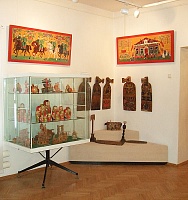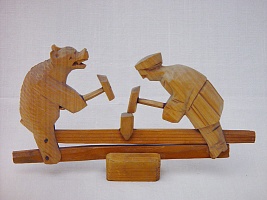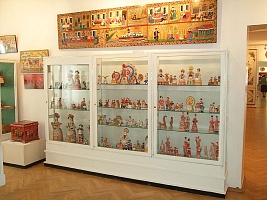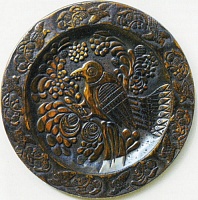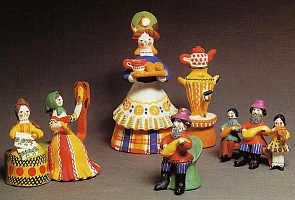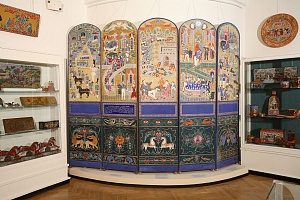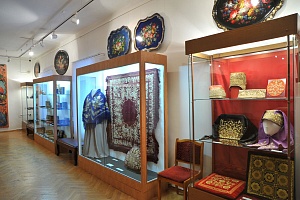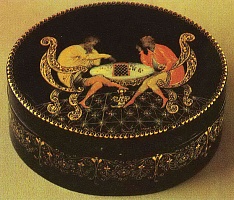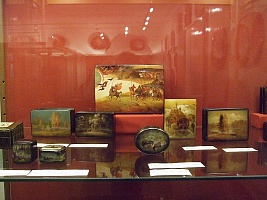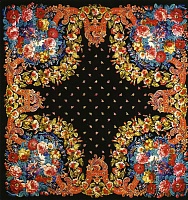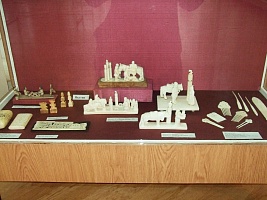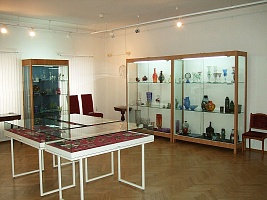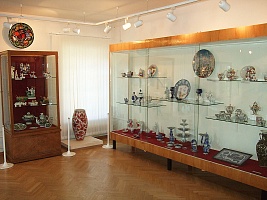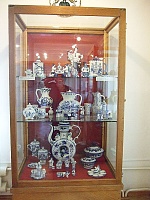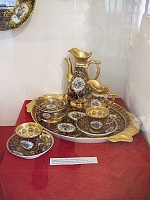Wednesday – Sunday 10 00 – 18.00
Ticket for 1 exhibition or exhibition:
- adult - 160 rubles.
- preferential - 80 rubles.
Photo and video shooting in the museum premises on the visitor's equipment (photo or video camera), without using a flash, tripod and monopod
- Photo - 170 rubles/person.
- Video - 230 rubles/person.
Russian Applied and Decorative Art of the 18th-–21st c. Open Depository

The exposition is situated on the second floor of the Southern Building of the Historical and Architectural Complex “Konny Dvor” of the 18th – 19th century. It demonstrates a large number of exhibits presenting the world-famous centers of artistic woodwork, lacquer painting on papier-mache and metal, leading centers of clay toys, printed shawls and kerchiefs embroidered in gold. These centers are concentrated in the Moscow, Vladimir, Vologda, Ivanovo, Nizhny Novgorod and other regions. The Museum collections of Russian artistic handicrafts were formed in the course of eighty years. They include samples of mass production, as well as, unique artistic works, made for All-Russian and International Exhibitions. Some items were specially commissioned. The highly artistic, diverse and comprehensive collection is regarded as one of the best in our country..
Toys occupy the main place in the exposition. Sergiev Posad is one of the most famous centers of toy production. The Museum presents ladies and hussars carved of a three-edged log, nurses, matryeshkas popular in the second half of the 19th – early 20th century and sets of architectural toys including “The Trinity-St. Sergius Lavra”.
The Bogorodskoye toys are closely connected with Sergiev Posad. Interesting toys of the 19th century are “General Skobelev on Horseback” made by P.F. Bardenkov, “A Man with a Bear” made by D.I. Puchkov. Amusing many-figured compositions illustrating Russian folk tales and scenes of new Soviet life were made in the 1930s by A.F. Balayev, N.E. Eroshkin, V.T. Polinov, A.G. Shishkin.
Local handicrafts are also represented by furniture, chests, boxes, plates decorated with carving, poker lines, ornamental painting. Local artists use Russian folk tales, architectural views of Old Russian towns, Sergiev Posad, folk art ornaments as main themes for their works. The Museum also presents an interesting collection of clay toys with rare 19th - 20th century samples. At present there are several centers producing clay toys, some of them, like Kargopol (Arkhangelsk), Dymkovo (Vyatka), Filimonovo (the Tula Region), Abashevo (the Penza Region), Skopin (the Ryazan Region) are known all over the world.
Village Khokhloma is historically connected with the Trinity-St. Sergius Monastery. In the 18th century Khokhloma and neighboring villages belonged to the Monastery. Light wood Khokhloma bowls, loving-cups, salt-cellars decorated with floral ornaments remind precious gold vessels. They were famous as early as the 19th century. Beside the traditional “gold” Khokhloma, the exhibition presents pieces of furniture of the 1930s with unexpected ornamental painting on the white and silvery backgrounds.
Another large wood-work center of the Nizhny Novgorod Region is Gorodets. The Museum collection demonstrates the main steps of its development from the end of the 18th until the end of the 20th century and presents practically all craftsmen who left marks in its history. The exhibition includes works that are considered “classical” samples of Gorodets art: details of distaffs made by A.V. Melnikov and L.V. Melnikov, G.L. Polyakov, V.K. Smirnov, panels of I. A Mazin, folding-screen made by I. K. Lebedev and D.I. Kryukov, etc.
Russian artistic lacquer painting is world-known. The collection reflects its history and acquaints with all major centers. The Museum displays painted metal trays of Nizhny Tagil and Zhostovo (Moscow Region), lacquer objects of paper-mache of the 19th – 20th century, produced in Fedoskino (Moscow Region) and in the centers of Ivanovo and Vladimir Regions: Palekh, Kholui and Mstera where art of lacquer miniature developed only during the Soviet period on the basis of icon-painting
The part of the collection, including Palekh lacquer miniatures of 1920 – 1930s, marked by the highest artistic level, is most valuable. It contains works of A.V. Kotukhin, I.V. Markichev, I.M. Bakanov, I.P. Vakurov, I.I. Zubkov and I.I. Golikov - the founder of Palekh lacquer painting. These artists were members of “The Palekh Team of Ancient Painting” founded in 1924.
The collection of Russian shawls and kerchiefs occupies a significant part in the exposition. The shawls and other items, embroidered in golden thread came from Tver and Nizhny Novgorod, and bright printed shawls were produced in Moscow and in the Moscow Region in the 19th – early 20th c. The largest and now the only manufacturer of wool printed shawls and kerchiefs is Pavlovsky Posad (Moscow Region). The production started at the factory of merchants Ya. I. Labzin and V.I. Gryaznov at the beginning of the 1860s. The favorite motifs in Pavlovsky shawls, like in Zhostovo trays, are flowers. The Museum presents shawls of different time. Two kerchiefs were designed by a legendary drawer of the 19th century S.V. Postigov. There are also works of our contemporaries Z.A. Olshevskaya, E.P. Regunova, K.S. Zinovjeva, I.P. Dadonova, N.A. Slashcheva, G.I. Sotskova.
Handicrafts constitute an important part of Russian culture. The Museum exhibits manifest great talents and refined artistic tastes of Russian craftsmen.
Bone with its decorative and technical qualities is a very attractive material for Russian craftsmen. As early as in the 17th century, ivory carving started to develop near Kholmogory in the Arkhangelsk province. In addition to ordinary cattle bone the Kholmogory craftsmen used walrus and sometimes mammoth bone for their caved works, which made them most valuable. The most popular goods were combs, boxes, chests and caskets, decorated with very delicate floral patterns, birds and animals in openwork carving and engraving. In the second half of the 19th – early 20th century, bone carving existed in the Trinity-St. Sergius Monastery in Sergiev Posad. The fact is proved by the “Trinity” icon of 1869 with the signature of Ivan Ilyin (monk Jonah) and a small ivory icon with the image of St. Sergius of Radonezh, made by the local carver I.S. Khrustachev.
The traditions of the local miniature carving in bone and wood encouraged the development of bone carving in Khotkovo near Sergiev Posad in the 1940s. This center is characterized by various techniques of bone carving, wide use of cattle bone and combination of bone and wood. These features are clearly observed in the works of the 1950s, especially in the box “Michurin” by V.E. Loginov, decorated with plaques of superb many-layer bone carving. The Museum exhibition also presents traditional bone-carving centers of the Russian East: Tyumen (Tobolsk), Yakutiya, Chukotka. Their identity is based on the ethnic and artistic traditions of the local population..
The Museum has formed a rich collection of Russian glass and porcelain. They developed rapidly in Russia in the 18th – 19th centuries. The Museum exhibits of that time are different in function, shape, technique and style. They were made at the leading factories: the Imperial Porcelain and Glass Plants, private Gardner, Popov, Kuznetsovs, Kornilov Porcelain Factories, Maltsevs, Bakhmetyevs Glass Factories, etc. The most rare items are engraved glass goblets of the 18th century and majolica articles, made at one of the first Russian ceramic factories, opened in 1724 in Moscow, by A.K. Grebenshchikov. The Museum preserves a remarkable collection of porcelain figurines, including various genre scenes and a complete series “Peoples of Russia”, which in the 19th century, was repeatedly resumed at Gardner and Kuznetsov factories in the vicinity of Moscow.
Glass and porcelain of the Soviet and Post-Soviet periods are mainly represented by the works, produced by the leading artists at the major Russian plants in the 1960s – 1980s. The leading place in history of Russian porcelain was always occupied by the Lomonosov (Imperial) Porcelain Factory in Leningrad and two Moscow region plants: the Dmitrov Porcelain Plant (former Gardner Factory) and the Dulevo Porcelain Plant named after the “ Pravda” newspaper (former Kuznetsov Factory). These enterprises represent two bright and original schools with their own style, high skill of the material treatment and deep traditions. Two schools are different, as they inherited different historical layers of Russian culture: Moscow school is based on the folk art tradition, Leningrad porcelain developed within the lines of all-European highly professional art of the 18th – 19th centuries.
The works of Petersburg (Leningrad) artists - A.V. Vorobjevsky, A.A. Yatskevich, V.M. Gorodetsky, N.P. Slavina, I.S. Olevskaya - are marked by exquisite taste and classical sense of proportion. The works of the Moscow region artists - P.V. Leonov, V.K. Yasnetsov, N.N. Ropova, etc. - are bright and colorful, corresponding to the folk conception of beauty in shape and painting. The exhibition also presents a collection of glass and cut-glass dating back to the second half of the 20th century. Tableware shapes, decorative vases, space and volume compositions were made by the leading artists at the oldest Russian glass plants: by E.I. Rogov, S.P. Verin, V.V. Korneyev, V.A. Filatov, V.S. Muratov at the Gus-Khrustalny Plant in the Vladimir region; by A.M. Silko, S. M. Beskinskaya at the “Krasny May” Plant in Vyshny Volochek district, Tver region; by M.V. Grabar, V.V. Soyver, V.Ya. Shevchenko at the Dytkovsky Cut-Glass Plant.
The Museum is proud of a considerable collection of glass items, produced at the Leningrad Artistic Glass Plant, which is connected with works of such masters, as L.O. Yurgen, A.A. Astvatsaturyan, A.M. Ostroumov, E.V. Yanovskaya, Kh. M. Pyld, B.M. Eremin, Yu. M. Byakov. The large part of glass and porcelain articles are unique specimens, created for major All-Russian and International exhibitions. Thus, the diverse Museum collection of traditional Russian applied and decorative art can be regarded, as one of the best collections in our country, considering its high artistic level and comprehensive representation of separate centers. It includes works of art, demonstrating great original talents of Russian craftsmen and their refined artistic taste.










